Innovation & Research
Because PCDL will be on the beach for 25 years, there is a unique opportunity to collect coastal data over a long period and to try different methods that can potentially make management of the beach more efficient, sustainable and more beneficial to the environment. A long term contract is attractive to research facilities as well, and Pevensey has already attracted a variety of research projects and will doubtless continue to do so in the future.
Innovation
Tyre bales as Substitute for Beach Material
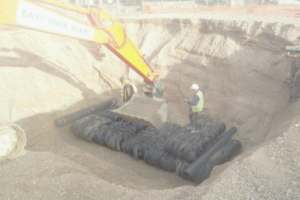 In November 2002, 350 tyre bales containing 40,000 used car tyres were buried in the beach in front of the Environment Agency depot on Coast Road. The trial is being used as part of a DTI scheme to examine whether bales of compressed, scrap vehicle tyres can help offer sustainable, economic and environmental solutions to some port, river and coastal engineering problems.
In November 2002, 350 tyre bales containing 40,000 used car tyres were buried in the beach in front of the Environment Agency depot on Coast Road. The trial is being used as part of a DTI scheme to examine whether bales of compressed, scrap vehicle tyres can help offer sustainable, economic and environmental solutions to some port, river and coastal engineering problems.
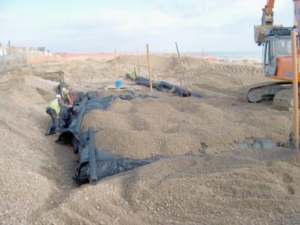 More details on this ongoing experiment can be found in the following fact sheets:
More details on this ongoing experiment can be found in the following fact sheets:
- Experiment on the eastern half filling tyre voids with beach material
- Experiment on the western half wrapping the tyres in geotextile
- Water quality monitoring I
- Water quality monitoring II
Use of a Box Scraper for Beach Recycling
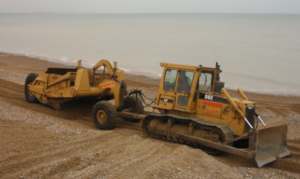 Recycling beach material requires at least three items of plant: an excavator for loading, dumptrucks for transport and a bulldozer for smoothing the material. At Sovereign Harbour, recycling ideally takes place over a stretch of a few hundred metres and so use of a 'box' or scraper has been tested since 2006. Scrapers are usually used for bulk earth movement, but adapted to be pulled by a bulldozer, approximately 400cu.m can be moved each low tide with the advantage that only two items of plant and one driver are needed. Since the transport occurs below the beach crest, it reduces the visible impact, dust and vibration caused by dumptrucks driving along the top of the beach.
Recycling beach material requires at least three items of plant: an excavator for loading, dumptrucks for transport and a bulldozer for smoothing the material. At Sovereign Harbour, recycling ideally takes place over a stretch of a few hundred metres and so use of a 'box' or scraper has been tested since 2006. Scrapers are usually used for bulk earth movement, but adapted to be pulled by a bulldozer, approximately 400cu.m can be moved each low tide with the advantage that only two items of plant and one driver are needed. Since the transport occurs below the beach crest, it reduces the visible impact, dust and vibration caused by dumptrucks driving along the top of the beach.
Plastic Planking on Groynes
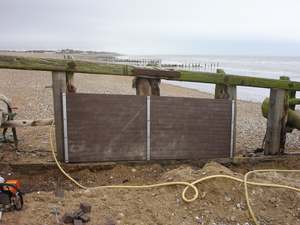 Groyne planks have traditionally been made of tropical hardwood or oak. In an attempt to find a more environmentally-friendly alternative, planks made of recycled plastic are being trialed. At Herbrand Walk fishing station, a panel of recycled plastic has been installed alongside new sections of Greenheart planking. These will be monitored over a number of years to see how the two different materials perform side by side.
Groyne planks have traditionally been made of tropical hardwood or oak. In an attempt to find a more environmentally-friendly alternative, planks made of recycled plastic are being trialed. At Herbrand Walk fishing station, a panel of recycled plastic has been installed alongside new sections of Greenheart planking. These will be monitored over a number of years to see how the two different materials perform side by side.
Research
University of Sussex
The University of Sussex carryed out research under the EU Interreg funded project: Beaches at Risk (BAR 2003 - 2007). The project is particularly interested in the behaviour of mixed sand and shingle beaches and their fauna and flora and has used Pevensey as a field site for a range of studies.
Pevensey Beach was sampled in a study to characterise the beaches of Southeast England and the results of this study can be found here.
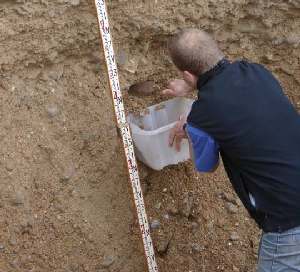 Investigations into the beach material that can be found at different levels within the beach have unearthed material that was on the beach face during the end of the 19th century. Based on detailed sampling of the beach material and the analysis of the grain size, sand content and composition of the gravel no trend could be observed. This means that observations that suggest that the beach has become finer or coarser are dependent onthe beach surface material that can change from day to day, but that the bulk properties of the beach have not changed over the last century. Additional information can be found in a brief description and a more detailed report about the investigations.
Investigations into the beach material that can be found at different levels within the beach have unearthed material that was on the beach face during the end of the 19th century. Based on detailed sampling of the beach material and the analysis of the grain size, sand content and composition of the gravel no trend could be observed. This means that observations that suggest that the beach has become finer or coarser are dependent onthe beach surface material that can change from day to day, but that the bulk properties of the beach have not changed over the last century. Additional information can be found in a brief description and a more detailed report about the investigations.
Some of the early experiments on longshore transport carried out during the project were located at Pevensey. A description of these experiments can be found in chapter 5 of a report on longshore transport.
University of Bristol
A probabilistic analysis of beach management using Monte Carlo simulations and neural networks has been carried out by Alice Johnson in 2001 to 2004. Abstracts of her PhD and a conference paper can be read by following the links.
Birkbeck College, University of London
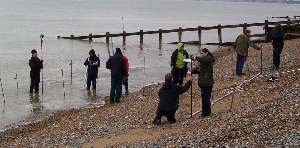 Birkbeck college is using Pevensey Bay for a number of undergraduate and postgraduate projects, investigating beach behaviour, porosity and beach water levels under different tidal conditions.
Birkbeck college is using Pevensey Bay for a number of undergraduate and postgraduate projects, investigating beach behaviour, porosity and beach water levels under different tidal conditions.
Southampton Oceanography Centre
Scientists from the Southampton Oceanography Centreare monitoring the water quality in the boreholes associated with the tyre bale experiment and undertake laboratory experiments to model the field measurements.
University of Southampton
An investigation into the calculation of beach volumes using GPS surveys was carried out by Paul Foley in 2003. The abstract of his MRes can be found here.
University of Brighton
Researchers at the University of Brighton undertook a Defra funded project "Impacts of Permeability on Beach Performance FD1923 (2005 - 2006)". This involved field measurements on Pevensey Beach and laboratory experiments.
In 2006 a PhD study started to investigate the conditions under which rapid beach erosion east of Sovereign Harbour occurs. The study uses frequent GPS surveys of the area and involves wave data collection and beach monitoring using video.




